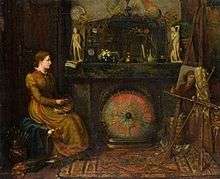Margaret Thomas
Margaret Thomas (23 December 1842[1] – 24 December 1929) was an English-born Australian travel writer, poet and artist.
Margaret Thomas | |
|---|---|
 Margaret Thomas, self-portrait, c.1881 | |
| Born | Margaret Cook1 23 December 1842 Croydon, Surrey |
| Died | 24 December 1929 (aged 87) Norton, Herefordshire |
| Nationality | British, Australian |
| Known for | Painting, sculpture, poetry, writing |
Career
Thomas was born at Croydon, Surrey, England, daughter of Thomas Cook, shipowner.[2] Her date of birth is often cited incorrectly as 1843 and she was herself inconsistent about both her age and date of birth. It has also been discovered that she was originally named Margaret Cook and only later changed her surname to her father's first name.[1] She was brought to Australia by her parents in 1852 and later on studied sculpture under Charles Summers at Melbourne. She exhibited a medallion portrait at the first exhibition of the Victorian Society of Fine Arts held in 1857. Thomas lived in Richmond, Victoria and exhibited her work regularly.[2]
Around 1867 Thomas went to Europe to continue her studies. She had a medallion shown at the Royal Academy exhibition of 1868; after studying for three years at Rome she obtained a studentship at the Royal Academy, London, and in 1872 won the silver medal for sculpture.
Between 1868 and 1880 Thomas exhibited her paintings (mostly portraits) at the Royal Academy.[2] In 1880 Thomas wrote a memoir of Charles Summers, her first master, A Hero of the Workshop, and in the same year completed a bust of him for the shire hall, Taunton. She afterwards did busts of Henry Fielding and other distinguished Somerset men for the same place. She began contributing verse to periodicals and in 1888 Douglas Sladen included seven of her poems in his Australian Poets.
In 1888, Thomas left England for Brittany and subsequently Rome, accompanied by her long-term companion Henrietta Pilkington (1848-1927). During the 1890s, they travelled throughout the Middle East and her book A Scamper through Spain and Tangier (1892) was dedicated to My dear friend, the companion of these wanderings. This book and Two Years in Palestine and Syria (1899), were illustrated by the author. In 1902 appeared an interesting little book, Denmark Past and Present, which was followed by How to Judge Pictures (1906), and a collection of her verse, A Painter's Pastime (1908). In 1911 appeared what was possibly her most valuable piece of work, How to Understand Sculpture. Another volume of verse, Friendship, Poems in Memoriam, was published in 1927 after the death of Henrietta Pilkington. She also did a large number of illustrations in colour for From Damascus to Palmyra, by John Kelman (1908). Thomas did not marry, although she spent much of her adult life with Henrietta Pilkington. The pair moved to Norton, Hertfordshire in 1911, living in a cottage known as Countryside in Croft Lane, where Thomas died on 24 December 1929[2] and was buried with Pilkington, who had died two years before, in Norton churchyard.
Thomas' portrait in oils of Charles Summers, and a medallion portrait of Sir Redmond Barry, are in the historical collection at the State Library of Victoria, Melbourne. Several of her sculptures and 27 of her paintings are in the collections of North Hertfordshire Museum, which also contains works by Henrietta Pilkington.
Thomas is also believed to have painted a number of middle eastern watercolours with a curious monogram consisting of an inverted L or Greek gamma (Γ) over a gothic M.
References
- Clarkson, C 2007 Oil Paintings by Margaret Thomas. North Hertfordshire Museums Service
- Tipping, Marjorie J. "Thomas, Margaret (1843 - 1929)". Australian Dictionary of Biography. Retrieved 12 January 2010.
- Serle, Percival (1949). "Thomas, Margaret". Dictionary of Australian Biography. Sydney: Angus and Robertson.
- "Mysterious Margaret" by John Ramm in Antique Dealer & Collectors Guide, Vol. 59 Nos 2&3, Sep/October 2005